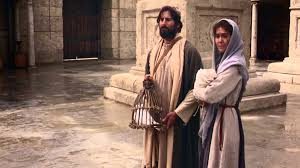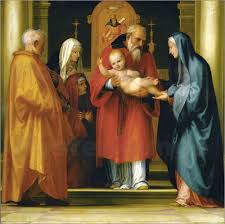The Presentation of the Lord
(Malachi 3:1-4; Psalm 23:7-10; Heb 2:14-18; Lk 2:22-24)
******************************************************
A traveller in Africa tells this true story of passing through a drought-stricken area and being followed by a small, emaciated, hungry shy boy who came out of the bush. Whenever the traveller stopped, the boy stopped also. Finally, he took out some food and left it on the road, moved on some distance and stopped. The boy came up to the food but did not take it. The traveller returned, and this time the boy stayed, only now with hands outstretched. The traveller tried as best he could with signs to signify that the boy should take the food, but he remained standing with arms outstretched. The traveller finally understood that the boy wanted to be given the food directly. Apparently in his culture, receiving and giving was a very honoured and ceremonial process, not to be taken lightly, even if one was starving.
This story, with its depth of sensitivity in giving, touches on the feast we celebrate today. First known as the Purification of Mary, this feast reaches back to the first half of the 4th century and is rooted in the Jewish tradition (the Law of Moses) that the first-born belonged to God and had to be “bought back” by a sacrificial offering 40 days after the birth of the child.

Since Christmas, through the feasts of the Epiphany, Holy Family, Mother of God, and Baptism of Jesus, the readings have been slowly revealing who Jesus really is: Saviour, Lord, Christ, Son of God, Messiah.
Today the readings continue that process, almost as another Epiphany, revealing him through the prophecies of Simeon and Anna as the “Christ of the Lord, Salvation, Light for the Gentiles, Glory of Israel, Liberator and as Suffering Servant.”
Given all these revelations of the Christ child, it is reasonable, even “right and just” that the Christological nature of the feast as the Presentation of the Lord eventually took over from the focus on Mary. Celebrating Jesus as the light of the world led to the tradition of blessing candles and candlelight processions as part of this feast.
The witness of both Simeon and Anna are key elements of this feast. Both have the best of credentials: Simeon, an elder, upright and devout, filled with the Holy Spirit, and Anna, married 7 years (a perfect Hebraic number), also now an elder, serving God in the Temple day and night with prayer and fasting. The strong inner life of Simeon and Anna allowed them to see beyond appearances and recognize Jesus as the Messiah, much like the Magi who came to worship him from afar.

In Redemptoris Mater (n. 16), JP II called Simeon’s prophecy of the rejection of Jesus and the suffering of Mary a second Annunciation. In the first mystical event, there was only joy because of the messianic royalty and supernatural manner of virginal conception. In this annunciation, Simeon describes the historical manner by which the Son of Mary will accomplish his mission, through misunderstanding, contradiction, sadness and by associating himself with Mary’s suffering.
Luke is careful to note that the parents observed all that the Law required, that they fulfilled the Law, although there is some divine irony here:
First, Mary through her Immaculate Conception and the virginal birth of Jesus had no need for purification. However, her participation in this ceremony was a renewal of the offering of her total self to God for the accomplishment of God’s plan of salvation.
Second, there was no need to present Jesus in the Temple, as he himself was the Temple in which God dwelt that would be destroyed and raised up in three days.
Nevertheless, Luke centres this story on the first cultic act of Jesus in the Temple in the Holy City. For Luke, Jerusalem is God’s chosen centre from which will spread the gospel of salvation. It is also the location of the Easter event and the starting point of the Christian mission. The “Christ of the Lord” is the one whom the Father anoints and consecrates for this saving mission. This child is the king of Israel, God’s chosen prince, the Messiah who is consecrated to establish the Kingdom of God. Jesus’ mission of light to the gentile world will bring hostility and persecution from his own people. As the true daughter of Zion, Mary will bear the destiny of her race and be at the centre of that contradiction.
What can we learn from this feast? Certainly, to develop a deep and profound life of prayer, consistent and faithful despite all obstacles so that like Simeon and Anna we can also see beyond the appearances of the events of our daily lives, recognize the Lord in everyone we meet, and glimpse the unfolding reality of the kingdom of God in our world.
Second, to pray for that sincere and profound humility shown to us both by Jesus in becoming so humbly one of us, and by Joseph and Mary by submitting to the Law of Moses even though their little one both fulfilled and transcended that Law to bring about a relationship of love rather than duty with our loving creator God.
Third, that we may surrender ourselves completely like Mary to the will of God, and that we would be open to some redemptive suffering for the sake of the Gospel, as were both Jesus and his mother Mary.
Lastly, let there be no contradiction in us. Let us choose where we belong. Let us place our faith in Jesus who came to set us free from the power of evil, from sin, from our own character defects, from addiction in all its forms. Let us allow him to be our Saviour, our Lord and Master, recognize him as the fulfilment of all human cultures and ceremonies, and live lives of happy, free sobriety mixed with joyful praise.
The Eucharist we celebrate today is our way of saying “Yes” to Jesus like Mary, to allow him to enter the temple of our bodies and persons, to transform us by our communion with him and with one another into his people, to send us out to love and serve as he did.




What a nice review about the Epiphany of the Lord Jesus Christ since it is the Presentation of the Lord . We should say ” Yes” to Jesus Christ have him enter our bodies and transform us once we receive the communion . That means we accept Jesus Christ and we learn to follow his foot steps and we allow him to do unto us when we consecrate ourselves to the Lord. Thanks for the message about the Presentation of The Lord , every first born male has to be consecrated to the Lord according to the Law of Moses. Amen. Blessings!
Thanks for telling us who Jesus Christ is and who he represents. Amen. Travel safely back home, I glad you a wonderful time down in New Port Beach , Los Angeles and Las Vegas .
I am glad you had a wonderful time in New Port Beach , CA .